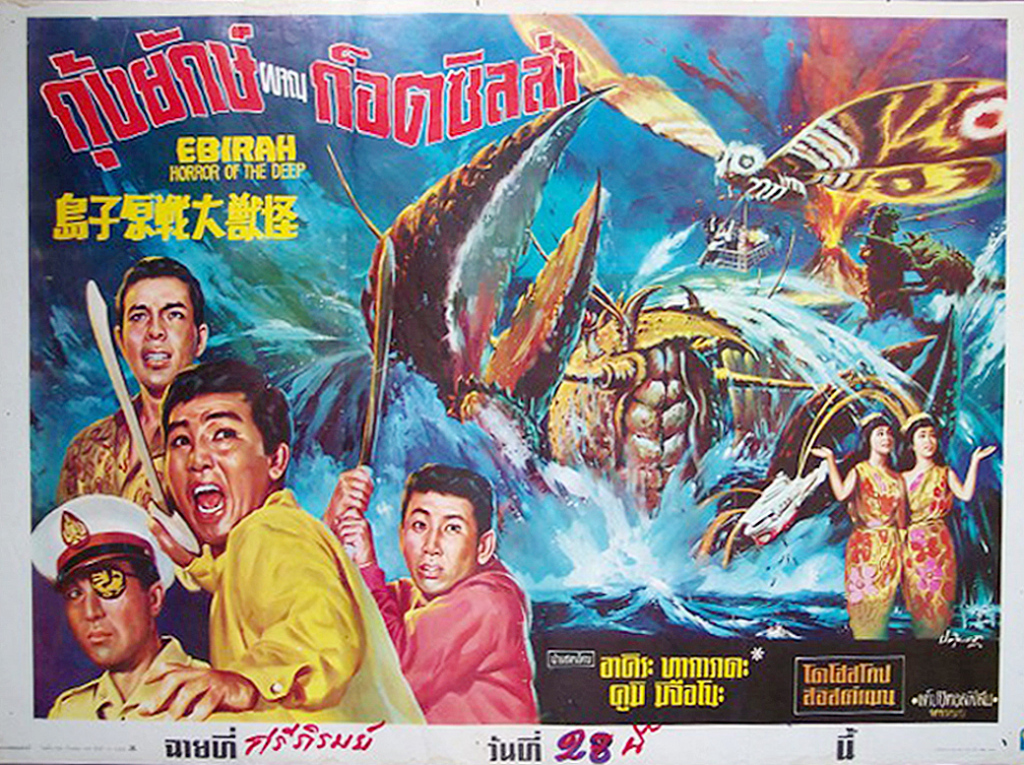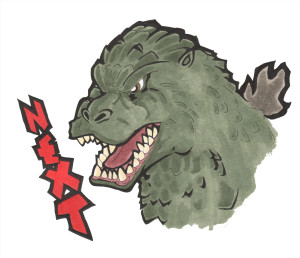Godzilla Versus the Sea Monster, AKA Ebirah: Horror of the Deep ~ 1966, Jun Fukuda – Japan

Immediately following Invasion of Astro Monster, which was perhaps Godzilla at his most recycled, we have Ebirah, Horror of the Deep, one of the freshest films in the series up to this point. Thanks, Toho, and not a minute too soon!
For Ebirah, we have a new director, Jun Fukuda, and his style is a serious breath of fresh air. While I would never want for this to sound like a dismissal of Ishiro Honda’s remarkable talents, I will say that there is certainly enough room under the kaiju umbrella for more than one voice at the helm of the Godzilla franchise, and if there was ever a time that new blood was needed, it was right around 1966. The movie also moves the action from Japan’s cities and countryside to a remote, tropical island, and this shift in setting only further accents just how off the badly beaten path this film was to the series at that time.
THE PLOT- Although his brother’s ship has been lost at sea, Ryota is utterly convinced that he is somehow alive. He’s so convinced, actually, that he ends up hijacking a boat and dragging three total strangers, one of whom is a damn bank robber, on a fool-hearty adventure to find and rescue his lost sibling, and the group wastes no time becoming shipwrecked themselves when they are attacked by a huge, lobster type monster named Ebirah, leaving them stranded on the shores of a mysterious island.

As the four soon come to realize, this island is controlled by a secretive paramilitary organization called The Red Bamboo, who have been using kidnapped natives from Infant Island as slave labor. Word of advice to the world’s paramilitary organizations; if you intend to kidnap islanders for slave labor, maybe pick a group that can’t pray to a giant, flying guardian monster to save them. I really hoped you’d use better judgment, guys.
Through their jungle adventures, our boys pick up a fifth friend, a female from Infant Island, and also discover Godzilla snoozing aggressively in a giant pile of boulders in one of the islands caves. Long story slightly less long, they wake up Godzilla, and shit get’s smashed. It’s really great!
 I imagine that Ebirah would be Godzilla’s most delicious foe.
I imagine that Ebirah would be Godzilla’s most delicious foe.
First, let’s talk about what Fukuda does that rocks my business so hard- his directorial style feels much more in line with the youthful bounce of 60’s beach cinema than Honda’s classical, 50’s screen aesthetic. While Honda’s work is tops, Fukuda’s feels great, too, and it really works in Ebirah. Here we have a noticeably more dynamic use of composition and moving camera, we have occasional zooms and dolly’s, even some dutch angles. The monster encounters are, in my opinion, drastically improved by this new, more dramatic use of camera, with angles shifting from claustrophobic close ups which stress the size of these beasts, to frantic, sometimes first person perspectives used in the fights between Godzilla and Ebirah. At one point, Godzilla’s fire breath is belched directly into the camera- I’m pretty sure that’s the first time I’ve seen that in this series, correct me if I’m wrong. This might be a controversial statement, but I feel that Fukuda’s use of camera in Ebirah is more effective when dealing with monsters which we are supposed to believe are enormous than what I’ve seen in previous Hondra directed outings, and I can’t remember being as impressed by the visuals in one of these movies since the first Godzilla film back in ’54.
The music undergoes a shift, as well. Akira Ifukube always brought a strange, Japanese folk inspired Bushido dirge to the series, but for this film we have a new composer, Masaru Sato, and, like Fukuda, he brings things up to date with a bouncier, zanier beach pop sound, and even some traces of surf rock guitar. I think it works, and it certainly adds to the film’s upbeat tone. Again, no disrespect meant, Ifukube is an absolute master and his work in the Godzilla franchise cannot be praised enough, but right now, we needed something new, and we got it. As a result, this movie benefits, and so does the audience.
On the setting: The tropical island thing isn’t totally unseen in these Toho kaiju pictures, but ordinarily, the action is always moved back to Japan and out of these remote locations. Not so with Ebirah, here, that’s where the meat of the story sits, and the implications of this give us a very different film. By removing the inevitably of city smashing and innocent casualties that are unavoidable when Godzilla thrashes around well populated areas, he is here free to stomp bad guys exclusively, and in this way he can continue his path toward becoming a more heroic figure, something Toho seemed interested in pursuing at this time. It’s also a lot more cooperative with the notion of the film being more fun and less dark, which it absolutely is. Hell, the Godzilla/Ebirah battle scene starts off with a rousing game of monster volleyball, and then leads into some Dick Dale guitar/submarine beast throw down type stuff, I’d have to think that Fukuda went into this wanting us to have a positive experience.

And I think you will. Only the stodgiest of Godzilla traditionalists would throw up their arms in protest of Fukuda’s treatment of Big Green, and my guess is most of those people died in the theater back in ’98 when Roland Emmerich’s American ‘Zilla film premiered, so we shouldn’t hear too many objections to this glowing review. Or will we?!?
A


